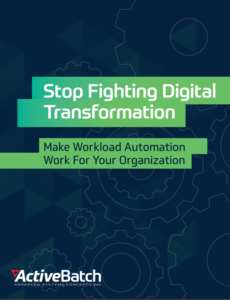Runbook Automation: What To Look For In RBA Tools

Runbook automation refers to detailed, organized processes that are executed for specific issues, common tasks or services. Runbook automation tools provide service catalogs with processes that can be triggered either manually or automatically, enabling IT members to respond to events without requiring subject matter experts or custom coding.
Runbooks help organizations standardize processes, promote consistency and optimize workflows, and have been used for decades in a physical format. IT teams use digital runbooks, such as runbook automation tools, to help manage routine processes, service requests, incident response, disaster recovery and more.
At a basic level, runbook automation (RBA) tools enable users to easily execute processes such as system restarts, backups and password resets, with the goal of reducing the mean time to resolution and improving service levels.
RBA technology has evolved to meet new IT requirements, providing new capabilities and benefits to the organization. Today, most RBA tools can be used to automate end-to-end workflows, enabling users to manage larger pieces of the process lifecycle. In this way, many RBA tools resemble IT process automation software.
Runbook vs. Playbook
Runbooks and playbooks have both been around for decades and share some use cases. However, runbooks are not the same as playbooks. A runbook is a collection of standalone tasks, whereas a playbook documents end-to-end workflows, standard operating procedures, corporate culture values, business guides and more.
In this way, runbooks are like recipes or cookbooks, whereas playbooks are like kitchen operating manuals.
Runbook and playbook are sometimes used interchangeably, especially in IT where runbooks are also used to automate end-to-end workflows. A playbook to a line-of-business leader however can mean something very different.
Runbook Features And Capabilities
Today’s RBA market includes both RBA and ITPA solutions, as well as other technologies that include competitive RBA capabilities. Many RBA products, such as Azure Automation and IBM Runbook, are interoperable with specific technologies. Others are platform independent so that IT can centralize control over a wider range of runbook processes.
RBA tools can also be segmented into groups. RBA tools can specialize in runbooks for DevOps, infrastructure management or ITSM, among other implementations. These are sometimes called specialized tools. Other RBA tools have evolved into ITPA or IT automation platforms, enabling users to manage a wider variety of automated processes.
Regardless, runbook automation software can be expected to provide a few key features and functionalities:
- Support for manual, semi-automated and fully automated runbooks
- Event-driven automation with prebuilt triggers
- On-premises and cloud-based interoperability
- Resource provisioning
- Self-service automation
- Self-documenting actions
Other common features, depending on the solution, can include:
- Monitoring and alerting
- Audit trails and extensive logging for compliance
- Analytics
- Browser-based dashboards or SaaS offerings
- Ability to ingest APIs, web services and custom scripts
- Configuration management
Don’t let IT complexity hamper your digital goals
Get the latest trends and data on what’s driving transformation and how IT teams address these challenges.
Runbooks For IT Operations
IT operations teams can use RBA tools for a variety of use cases, including ITIL, ITSM, infrastructure, disaster recovery and more. This is made possible in part with event-driven automation. The RBA capabilities you will need depends on how your team will be using the tool.
RBA tools for IT ops teams can provide the following capabilities:
- SLA monitoring to trigger follow-up or remediation workflows when operations processes are delayed or at risk of failure
- Automated provisioning to scale-up resources, maintaining availability and performance during spikes in demand
- Easy-to-use search functionality to locate processes that are required for incident management or service desk requests
- Triggering operations tasks based on IT tickets or escalations
- Provide runbooks for business continuity, including automated failover processes
- Notifications that deliver documentation and other information to streamline troubleshooting
RBA For DevOps
Runbooks make it easy for IT members to respond to events by documenting and organizing processes. This allows users to resolve issues quickly and without expertise. For IT shops, this means that developers can handle more responsibilities that are traditionally exclusive to operations teams.
RBA tools can also provide specific functionalities for developers, helping to streamline the development lifecycle. This includes:
- Ability to ingest APIs, web services and custom scripts
- Full audit trails
- Low-code or no-code workflow designers
- Reusable templates
- Release management
- Change management
Whether you’re looking to deploy RBA for developers, operators or DevOps, RBA capabilities can be found in a variety of other technologies, including service management platforms, IT infrastructure management and business process management solutions.
Deciding Which RBA Tool Is Best For Your Organization
Runbook automation is critical to making digital processes accessible and understandable, which in turn can reduce mean-time-to-resolution (MTTR), improve SLAs and eliminate manual tasks so IT can turn to higher-value projects.
As IT environments become more complex, and processes more numerous, clearly identifying the right processes at the right time, and automating responses to common issues, help desk tickets and disaster recovery is essential.
For this reason, many IT technologies offer runbook automation capabilities that can help your IT team reach its goals without deploying additional tools. These IT technologies include:
- IT process automation
- Business process management/automation
- Workload automation software
- Service management
- Service orchestration
- Infrastructure management
In some cases, these tools provide the extensibility necessary to build end-to-end processes that can respond to any event within the enterprise. Workload automation (WLA) tools for example can connect to any endpoint using a REST API adapter, triggering cross-platform workflows based on IT or business events.
Additionally, WLA tools can be used to:
- Enforce documentation requirements
- Segment permissioning based on roles (developers, operators, service desk, etc.)
- Organize processes within directories
- Alert users of issues with notifications that provide useful information
- Trigger auto-remediation
- Provision cloud-based servers or VMs
Emerging Technologies In Runbook Automation
RBA vendors are investing in new features and capabilities for their product offerings, enabling IT teams to take on new challenges and leverage new technologies.
Today, automation and orchestration platforms can provide a range of advanced features, including runbook automation, so that IT can manage events across IT systems. Such features can include:
- Real-time monitoring for faster remediation and issue prevention
- Microservices that accelerate development of new processes
- Advanced analytics to optimize existing workflows and resources
- Machine learning and artificial intelligence to discover processes, increase uptime, manage complex environments and more
Real-time analytics and machine intelligence are helping organizations introduce autonomous IT environments, with self-healing systems that bring NoOps closer to reality. This includes leveraging AI to prevent future issues and responding to incidents so that IT can dedicate more time and resources to development and innovation.
The right runbook automation solution for your team is going to depend on your organization’s goals, on whether an event-based process automation tool will meet your IT needs, or if a broader automation and orchestration platform can reduce the need for redundant solutions.
Ready to simplify your data warehousing with workload automation?
Schedule a demo to watch our experts run jobs that match your business requirements in ActiveBatch. Get your questions answered and learn how easy it is to build and maintain your jobs.








